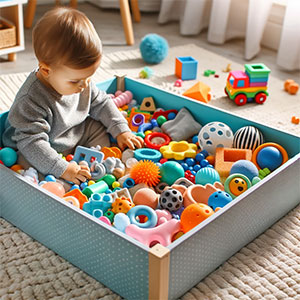Sensory Bins for Toddlers

Sensory play is crucial for the cognitive and physical development of toddlers. Sensory bins, with their diverse mix of textures, colors, and shapes, provide a rich playground for little explorers. Not only do these bins stimulate the senses, but they also encourage fine motor skills, foster creativity, and aid in language development.
What are Sensory Bins? A sensory bin is a container filled with materials that engage a child’s senses. They typically include a base material, like rice, beans, or water beads, and various small toys or items for toddlers to explore. The beauty of sensory bins lies in their versatility; they can be themed, seasonal, or designed to develop specific skills.
Benefits of Sensory Bins:
- Enhanced Fine Motor Skills: As toddlers pick up small objects, they improve their dexterity and hand-eye coordination.
- Cognitive Growth: Exploring different materials helps toddlers learn about concepts like volume, cause and effect, and problem-solving.
- Language Development: Describing what they feel, see, and do while playing can boost their vocabulary and communication skills.
- Emotional Regulation: Sensory play can be soothing for many children, helping them to manage their emotions.
How to Create a Sensory Bin:
- Choose a container: Any large, shallow container works. Ensure it's safe and easily accessible for your toddler.
- Select a base material: Rice, beans, water, sand, or pasta are great options.
- Add tools and toys: Include items like scoops, funnels, toy animals, or magnetic letters.
- Safety first: Always supervise playtime and avoid small items for children under three.
Sensory Bin Ideas:
- Nature Explorer: Fill a bin with sand, add plastic bugs, leaves, twigs, and a magnifying glass.
- Ocean Adventure: Use blue water beads, add sea creature toys, and small nets for 'fishing'.
- Construction Zone: Base of dry beans, with toy trucks, shovels, and building blocks.
Sensory bins are more than just play. They're tools that nurture curiosity and development in toddlers. By incorporating sensory bins into your child’s playtime, you're laying a foundation for a lifelong love of learning.